 The other day I ran across a video posted on social media: A man wearing a backpack stood in the middle of a valley flanked by snow-capped mountains. Animated clips flashed on the screen, emphasizing his impassioned plea to live your dream—your purpose—now. He talked about how people on their death beds are less likely to regret the things they did in life as opposed to those they didn’t.
The other day I ran across a video posted on social media: A man wearing a backpack stood in the middle of a valley flanked by snow-capped mountains. Animated clips flashed on the screen, emphasizing his impassioned plea to live your dream—your purpose—now. He talked about how people on their death beds are less likely to regret the things they did in life as opposed to those they didn’t.
It doesn’t matter if you’re 22 or 92; it’s only too late when you entertain regrets of the ‘could’ve, would’ve, should’ve’ variety. Here are 10 tips to help you pursue your passion regret free:
- Start where you are. Every day is a new beginning—a clean slate to embrace in all its quirky imperfections. As the narrator of the video stated: “You cannot start over, but you can start now and make a brand new ending.”
- No right way. There is no magic formula for getting from point A to point B. Your mantra might be ‘trial and error’ or ‘go with the flow.’ Modify as needed.
- Quit comparing. Joseph Campbell writes: “The privilege of a lifetime is being who you are.” You’ve heard the saying: Life would be boring if everyone was the same. Now live like you believe it.
- Life doesn’t stop. Stuff happens. Appliances break down, illness and injuries occur and sometimes bad news arrives in threes. Do what needs to be done and then see #1.
- Change of scenery. At times it may be necessary to step out of your comfort zone in order to follow your dreams. This might include changing a routine or your surroundings. Be open to the possibilities.
- Have fun. Oscar Wilde writes: “Life is too short to be taken seriously.” Laughter provides a balm to the soul and lightens the load. Lift the corners of your lips often.
- Refuse to fear. Jack Canfield says: “Everything you want is on the other side of fear.” If fears are stories you tell yourself, then change your story.
- Remove distractions. Shut down when necessary; i.e., disengage from social media, email, etc. The world will not stop when you go off the grid to pursue your passion.
- Prioritize. Each day tackle the easiest, fastest tasks first. Then dive into your pursuit and camp out there as long as it takes. The piles of dirty laundry aren’t going anywhere.
- Delegate, ask for help. It’s okay to say ‘no,’ or to pass the buck, in order to create space to chase your passion, which is the one thing no one else can do for you.
The narrator in the video closes by illustrating how a plane is less safe when on the ground because it’s prone to rust and deterioration. When you don’t live your dream—your purpose—you clip your wings and ultimately remain grounded, much like that plane. Mired in regret. But when you put wings on your passion, you begin to take flight.
John Greenleaf Whittier states it best: “For of all sad words of tongue and pen, the saddest are these, it might have been.”
What’s your advice to avoid the ‘could’ve, would’ve, should’ve’ mentality?
Image courtesy of Stuart Miles at FreeDigitalPhotos.net.


